
Moon Clock
Geomagnetic/Auroral Activity for past 24 hours
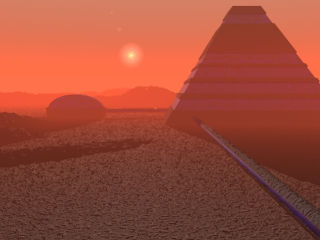
Cydonia, the Face and the Cities of Mars
I originally came across this anomaly in 2003. It was 2003 and the opposition of Mars was at hand. So naturally I was at the library fossicking for books on Mars when I came across a book grandly titled "The Monuments of Mars - A City on the Edge of Forever." by Richard Hoagland. Adding it to the pile, I checked out and when I got home started to browse through it.
The Viking 1 Orbiter snapped an unusual photo. A mesa resembling a shadowed human face. NASA's line was that it was a chance arrangement of shadows and light.
Richard Hoagland, the author, disagrees and makes the following assertions:
-
The Face is an artificially created monument - as a message to Us.
-
There exists a ruined city nearby the face. The buildings take the form of massive arcologies.
-
The Face and the City are aligned to allow the observation of the Summer Solstice and the heliacal rising of Earth at the epoch of construction of the City/Face complex, asserted to be 500,000 years ago.
-
There are mathematical relationships encoded in the construction, alignment, layout of the City, Face and other structures in the area.
-
That the beings that lived on Mars in the City and who created the Face, in the balance of probabilities were not indigenous to Mars. That given that the technological remains of an advanced culture may not endure millennia of erosion and planetary change, these beings used the Neolithic permanence of stone to leave a message to us.
-
There is evidence of a nuclear holocaust that wiped out these colonists.
-
There is a connection between the Face on Mars and Egypt (The sphinx? Pyramids?) and the Sumerian culture.
-
That the location of the City on Mars and other "anomalies" in the solar system relates to "Hyper dimensional Physics"
So where do we begin!
This topic being what it is, there is a staggering volume of material for anyone who is trying to look objectively at it all, so I have chosen to look at a couple of the key features - the Face and the D&M Pyramid. In some aspects I may have simplified matters, however I have tried to present the gist of the arguements - there is simply too much material and only so much time!
Where is Cydonia - A description of the Region.
This montage is composed of Viking orbiter images and is bordered by Latitude 41.7N, latitude 39.7N, Longitude 10.6W and longitude 8.6W.
Various NASA sources catagorise the form of the region as being mostly due to erosion. The mesas and other landforms that protrude are the remains of the bedrock, the rest of the region is covered in a rubble of erosion materials.
The Cydonia region is halfway between the more heavily cratered highlands of Arabia Terra and the smoother lowland regions of Acidalia Planitia.
In the late 1980s scientists proposed that this region was on the edge
of an ancient sea-shore. The difficulty in proving (or disproving) this
theory related to the poor resolution of the imagery, and that testing the
soils directly was the easiest way to establish the facts of the matter.
However the 2004 NASA rovers have established the presence of minerals
that our current understanding suggest as being most easily formed by the
presence of liquid water that existed for an extended
time.
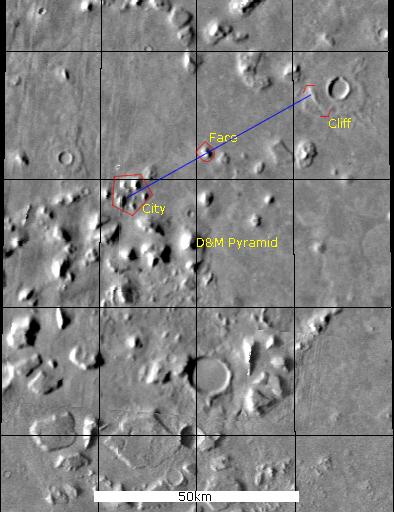
The Cydonia Region and it's "anomalous"features.
Scale = 0.2314 kilometers per pixel (true at the equator).
The images used in this web page are processed from original TIFs sourced from NASA, JPL and their associates. The original images are often several megs in size. In order for me to use them they had to be loaded into Paint and converted to 24-bit BMPs. All images on this web page have been processed with Uleads Photoimpact software (v5.0)
The web being what it is, links do age and sometimes expire. I am more than happy to send to anyone who requests, the original files that I have gathered up in creating and researching this topic.
The Face that launched a thousand websites.
The Face, the Face... Everything started with this.
The Face is a mesa-like formation that measures approximately 2.7km in width and 3.6km in length. The long axis of the face is orientated approximately 32ยบ to 38ยบ from true north. (The uncertainty is entirely due to the small scale of the image I had to work with.)
The original images from the Viking 1 Orbiter were not of the best resolution (a little over 200m per pixel) so clear imagery of the face required much enhancement, and the scale was small.
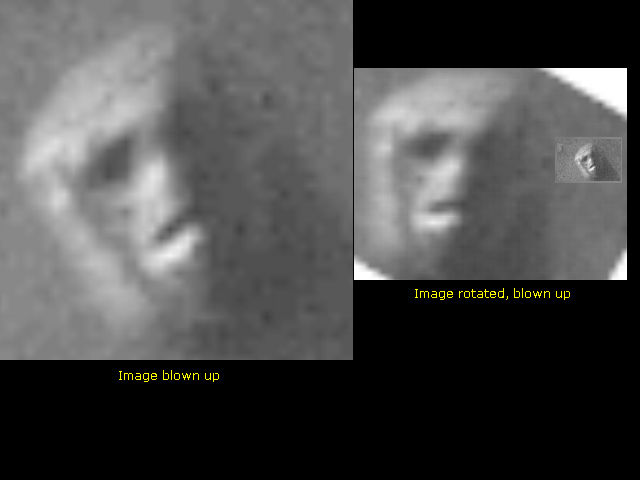
The above images are from one of the clearest images I could find of the region of the Face. However it's not until you blow up the images with a computer, that some of the "details" come out, now the question is, are these details real or a computer artifact?
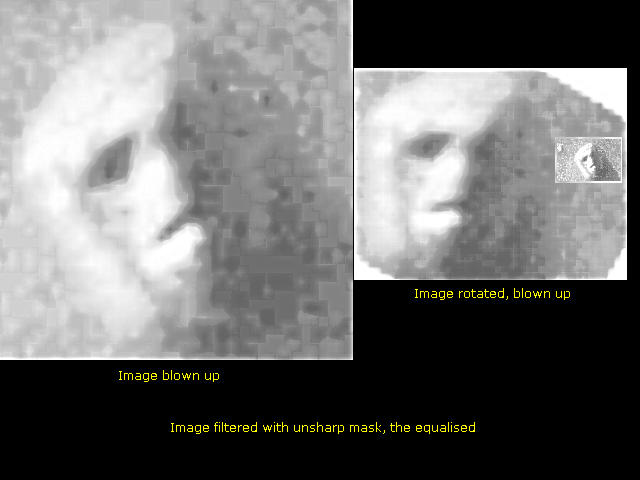
The images has now been filtered with an unsharp-mask (Sharpens the image by subtracting a value as determined by the average pixel values in a specified cell size from each pixel in that cell.) and then equalised (the levels of lights and dark are equalised across the pixels in the image, can bring out details in dark areas) Among the features you can see are teeth (but only in the left hand image, can you think why?) and a pupil in the left eye. Hoagland asserts that these are real features.
The smallest image in each picture clearly shows the pixels. In blowing up the image the computer averages pixels to fill in the gaps. The teeth are the corners of the original single pixels in the very small image. The pupil in the eye is a similar artifact. The image that was rotated first then blown up, does not have teeth, as the pixels that make up the mouth are in a horizontal line, which has no jagged corners
However Mr Hoagland contends that the teeth and the pupil are proof that this is actually the sculpture of a giant face. The Egyptian-style head-dress is the sloping edge of the mesa, but the curved lower portion of the mesa is lost in shadow, and so does not show up in the "enhanced" images.
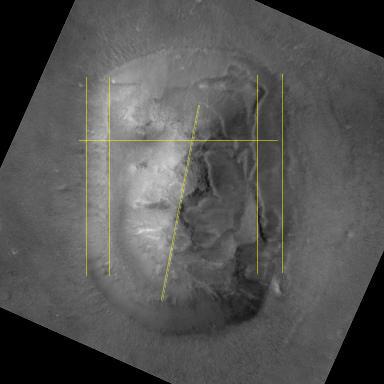 This image has been processed.
This image has been processed.
Since the original images were obtained, several probes have been sent to Mars, including the Mars Global Surveyor which have returned imagery of clearly superior quality. The latest images of the face have a resolution of 2 metres per pixel (As opposed to Viking's 200m/pixel) One of the clearest is available from the Planetary Photojournal (Use the "other search options" to find image number PIA03225) and to be blunt, it speaks for itself. Only when the image is softened and blurred by poor resolution and distance does the "image" of the face start to be seen.
Closer viewing of the mesa shows that the "nose" is skewed and there are no teeth in the "mouth" which in itself, is not a complete gash across the face. The right side of the face is not symmetrical with the left, and the proportions of the width and the length do not equal the architectural proportion known as the Golden Ratio (1 to 1.618) as asserted by Mr Hoagland.
I am not convinced that the forms on top of the mesa are an artificial sculpture to create a "face". The symmetry of the "base" is intriguing, but it may not require an artificial explanation as to it's shape.
The difficulty lies in the interpretation of what we are observing. The MGS images have a resolution 100 times better than the original Viking images. But the details shown do not gel with the conclusions originally drawn from Viking. Linearity does not necessarily imply a non-natural origin. And given newer and more accurate data, it's better to revise what you know against it.
Mr Hoagland talks about this in his book about "terrestrial prejudice". This is the subjectivity that we bring to the activity of observation. This subjectivity plays an even larger role when it comes to interpretation of what we are seeing, as we are basing the act of interpretation on the sum of our experiences. Now, if we include experiences that have come about through rational and logical thinking, through experiment, our experiences that we bring to observation are hopefully more objective. This does not remove the subjective component, but it hopefully dilutes the proportion of it when it comes to interpretation. (As human beings, our brains seem hardwired to link observation to interpretation. By doing this we are attempting an understanding of what we are seeing, and inevitably, how it relates to us.)
The preceding paragraph may seem overly philosophical, but what I am trying to say is this - we cannot remove the terrestrial prejudice from observation, because (for the foreseeable future anyway) all our experiences come from life here, on Earth. So, when it comes to interpreting non-Earth phenomena we must be careful in giving explanations to things we see that have been shaped, influenced, or have evolved outside the confines of Earth.
Conversely, rational explanations for non-earth phenomena may seem outlandish and nonsensical compared to "common sense". (think of the general weirdness that is Quantum Theory)
Unfortunately this argument on it's own can be turned for or against the idea that the Face is an artificial construction! However by being as objective as we can, we can see that the details of the face that argue for an artificial construction as derived from Viking (the eye, mouth, teeth, and form of the face), do not have recognisable counterparts in the MGS images, i.e.: the pupil in the eye should at least show as a ruined circular aperture. I would say that given the more detailed images available to us, that these do not support the conclusions taken from the Viking images, and that therefore Face is not an artificial construction.
The City and Pyramids of Cydonia
Pyramids on Mars and the D&M Pyramid
Pyramid structures (called massifs) are quite common on Mars. They are often 3-sided. The geological explanation is that for the most part the massifs and mesas are composed of hard bedrock that protrude through the erosion material of the plains round the them.
Here is a reduced and processed (unsharp mask) image of the feature known as the D&M Pyramid (named after it's discoverers Vincent DiPietro and Gregory Molinar) The image ID is PIA04745. Again, people should download this image and see for themselves what is there - the image scale of the original is approx 6 metres per pixel.
In Mr Hoagland's book, the Viking image of the pyramid he uses shows a deep dark crater on the right (between C and C1). The sides of the pyramid are also buckled. The appearance of these craters plus the distorted look of this pyramid he attributes to some kind of nuclear holocaust amongst the colonists on Mars.
Clearly this is not the case. This image from Mars Global Surveyor
shows that crater does not exist.
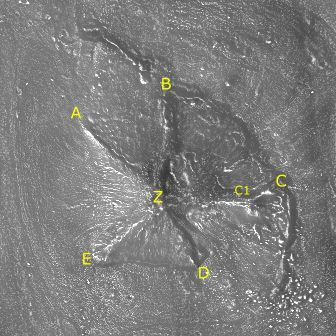
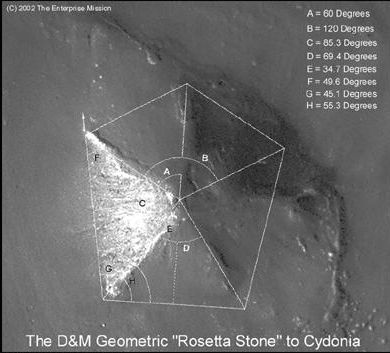
I have to admit that I thought the pentagonal symmetry was better with the "top" of the pyramid at D rather than at B. Never mind. I guess this would ruin the assertion of an alignment with the face and city. However this causes us a problem! In order for the Pyramid to be as symmetrical as Mr Hoagland would like, we need another arm somewhere between B and C1. The arm ZC1 is explained as some kind of damage, and is not the arm we need.
| External Angles | Measurement | Idealised Angles (Hoagland) |
| AZC1 (Angle B) | 140º | 120º |
| BZA (Angle A) | 54º | 60º |
| ZAE (Angle F) | 41º | 49.6º |
| AZE (Angle C) | 94º | 85.3º |
| EZD (Angle D) | 70º | 60º |
| AEZ (Angle G) | 43º | 45.1º |
| ZED (Angle H) | 49º | 55.3º |
The angles just don't quite match! One could argue it depends where you want to define the edges and corners of the pyramid. However I would argue that the lack of the "correct" corner C1 makes if difficult to "prove" the angles and "geometry" of Mr Hoagland. It also makes it difficult to argue that the D&M pyramid is geometrically arranged to the Face and City, and is an artificial structure. There is just too much margin for error!
The D&M feature displays an intriguing symmetry (but not the symmetry of Mr Hoagland), and would undoubtedly be worth a visit when we send astronauts to Mars, but I am not yet convinced that it is an artificial structure.
The City
Approximately 24km SW from the Face lies the feature called the City - consisting of several "pyramids", a "square" and a "fort". South-east of the city is a pentagonal feature called the "D&M pyramid" The structures in the city are aligned to the Face in such a way that an observer can purportedly observe the sunrise of the Martian summer solstice, at the epoch that the structure was built, across the face against the backdrop of a faraway "cliff" that may have built up for this purpose. The Cliff is approximately 52km in a line from the City across the Face to the NE.
Hoagland argues that the "pyramid" structures are arcologies. An arcology is a concept devised by Paolo Soleri, whereby instead of cities developing out as 2D urban sprawl, they build up (or down) in 3D structures. Arcology comes from the words architecture and ecology expressing the idea of human architecture that should be in harmony with the surrounding landscape. Hoagland believes that beings who had come to Mars and were therefore used to the confines and closed-ecology of long distance travel, would find it natural to live in self-sustaining arcologies on the arid surface of Mars.
Hoagland also asserts that there is evidence (small impact craters about 1km in diameter) of nuclear explosions in the city, and that damage to the "pyramids" shows the internal structure of the arcologies.
On the face of it, images of the site do not really seem to be able to prove the existence of arcologies. The biggest problem is understanding the appearance of half a million years of erosion! For example:
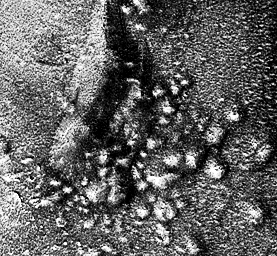
This image is the bottom right corner of the D&M pyramid (see image at top of the page). It has been enhanced (equalised) to improve the contrast.
According to Mr Hoaglands website, this rubble is the eroded remains of the outer cladding or casing of the D&M feature.
Or it could be just random rocks and boulders!
I do not believe that there is enough evidence from the current satellite images we have so far that proves conclusively that the D&M pyramid is an artificial structure, or that the "city" is a group of such structures.
Mathematical relationships.
Much is made of alignments and angular relationships within structures at Cydonia and between them.
The first alignment Hoagland discovered was the City-Face-Cliff line. At first he couldn't see what the point of this arrangement was, until he surmised that perhaps it was a solstice marker of some description.
The occurrence of a solstice has to do with the fact that the polar axis of most of the planets, is tilted in relation to the plane traced out by their orbits around the sun. As a result, to an observer on the surface of a planet, the sun's path across the sky appears arc higher in summer than it does in winter, giving us our Longest Day and Shortest Day, etc. Early Neolithic cultures on Earth marked the sunrise and sunset on these days with the building of henges, monuments, standing stones, horizon markers, etc.
However, the City-Face-Cliff alignment didn't point to the current solstice. So Mr Hoagland surmised that maybe they did in the past. For all the planets, the polar axis tends to wander in small circles which causes the points on the horizon where the solstice risings happen, to wander as well (This is called precession). Logically enough, if you can calculate when the solstice arrangement occurred for the City-Face-Cliff alignment, then you calculate when that structure was supposedly built. Mr Hoagland comes up with a figure of 500,000 years ago.
Alas that orbital mechanics is not a topic you can master in a quiet Sunday afternoon. And thrice woe that I don't have a natural affinity for calculus and differentiation! :-)
For most of my astronomical work I use a piece of software called Redshift, which only goes back to 4700 BC, so it can only show me solstice risings for then.
However, I have been able to discover the following information. For a start, Mars's axial tilt (obliquity) cycles between 15º and 35.5º every 1.2x106 years (Currently, Mars's obliquity is 23.98º). Mars's spin axis and it's equatorial orbit also precesses and this has a cycle of 25,000 years.
But seeing as we're out on the limb of conventional explanations, here is a random side-note
Ley-lines were originally proposed by an early 20th C amateur archeologist to explain the seeming non-chance alignment of megalithic features, often over tens of miles. Churches, standing stones and henges all seem to link up to a network of lines. Originally hypothesised as markers for ancient trade routes, they've been embellished into mystic conduits of earth-energies, etc.
Statistical studies of the lines have shown that given a random population of features there are often plenty of alignments that occur by chance alone, that encompass 3 or more features. Obviously, the more features that occur in as short a line as possible, means that it is more likely that the alignment is artificial, but 3 features only (like the city-face-cliff) are not considered statistically significant!
A Conclusion.
I believe many of the images presented by Mr Hoagland and many of his supporters are over processed, and that the "physical structures" on the surface are artifacts of the image processing itself. This is made worse by the poor quality of the original images that are used. It is an astronomical example of an Rorschach test.
Details in the superior images of the face taken by MGS do not match details that have been "enhanced" from the original Viking Orbiter pictures.
Mr Hoagland states that the features on their own are not the clincher for proving artificiality, but taken as a whole, the arrangements and alignments, the small mysteries and anomalies in the region make it unlikely that everything we see here is the result of natural phenomena at work.
Mr Hoagland attempts to prove a "tetrahedral" geometry in the Cydonia region and link it to the presence, and use of some kind of higher-order manipulation of space and time which he calls "Hyperspace Physics". This is nothing but extreme speculation of the highest order. Many of the angular measurements used to "support" his geometry are off by anything up to 10ยบ or more. Plus there is nothing in his book to show the connection between the angles and the "physics"
If aliens inhabited Mars, built the face and a city and created us, had migrated here from another star, then you have to ask, that given the scale and sophistication of the technology they must have needed, and supposing that they did want to leave a "message" to their genetic progeny, why did they leave their message on the rubble strewn surface of a planet that they must have know would erode and degrade anything they left behind? If these beings were comfortable with the scale of building arcologies to live in, a more certain monument would have been something in orbit, either around Mars or the Earth, or parked in the Lagrange point of the Moons orbit (a region of gravitational stability).
 Even better would be to add to this monument, something that
would require advanced technology to create, yet that we could detect now.
Combine this with a form that speaks obviously of intelligent design, and
then you would have the perfect message to an alien culture that you have
existed.
Even better would be to add to this monument, something that
would require advanced technology to create, yet that we could detect now.
Combine this with a form that speaks obviously of intelligent design, and
then you would have the perfect message to an alien culture that you have
existed.
In the balance of things, I do not believe that Richard Hoagland has conclusively proven the existence of a city, monument or anything else on the Mars that was created artificially.
The Enterprise Mission is the official website for the Hoagland camp. Intriguing images and even more intriguing explanations are there. So is a rather unhealthy dose of conspiracy-theory driven paranoia directed against the likes of NASA! You Have Been Warned! :-)